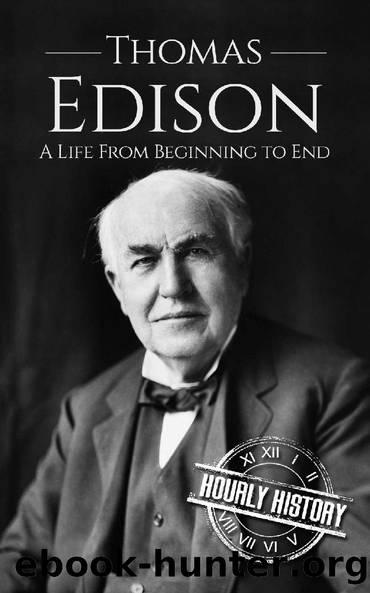Thomas Edison: A Life From Beginning to End (Biographies of Business Leaders Book 1) by Hourly History

Author:Hourly History [History, Hourly]
Language: eng
Format: epub
Publisher: Hourly History
Published: 2017-03-07T00:00:00+00:00
Chapter Six
Let's Go to the Movies
âI've always said that Thomas Edison invented the movie camera to show people killing and kissing.â
âQuentin Tarantino
Back in the late 19th century when Edison was heavily involved in many diverse inventions, life was a lot different from what is experienced today. Because he had turned his head away from the public while involved in litigation and patent infringements, Edison had quickly lost touch with how people were feeling in the culture of 1890s America.
Once his phonograph was invented and marketed there were other inventors making improvements on it without violating any of Edison's patents. This was because citizens were demanding that music be recorded so they could listen to it. Edison still believed a phonograph should never be used for recreational purposes, but only in business for recording and dictation purposes.
There were stage shows in those days, and many enjoyed the burlesque and vaudeville shows that moved around the country. Yet, now that people were able to stay up late in their homes because of electric lighting, they were clamoring for more to do with an eveningâs entertainment.
By 1888 Edison was working on a device that would âdo for the eye what the phonograph does for the ear.â He was granted a patent for a motion picture camera or what came to be called the âkinetographâ. He left the bulk of the development to his chief photographer William Dickson while Edison worked on the electromechanical design. In fact, the design of the camera actually belongs to Dickson.
The kinetoscope or peep-hole viewer was developed in 1891 by Edison and was initially installed in penny arcades where people could enjoy short films. The kinetoscope was driven by sprockets that pushed a flexible film strip through the device, and suddenly pictures were moving.
In order to see films moving through the kinetoscope, you needed people to produce them. Dickson was the one who constructed a movie studio which he dubbed the âBlack Maria.â The studio was small, mounted on a turntable and let in plenty of sunlight through its retractable roof, so there was ample light for filming.
Immediately Dickson started creating short films for the general public. Another Edison assistant saw the commercial value in producing such works. It was Tate who purchased a shoe shop on Broadway in New York City and turned the shop into the first kinetoscope parlor. Because the 10 machines that were delivered there didn't have coin slots, he printed up paper tickets for admission. These became the first movie tickets.
Once Tate and his assistants opened the kinetoscope parlor people flocked there to see the latest film. What they didn't want to see was the same film again and again, so Dickson realized that more films were necessary and needed immediately.
During the 1890s, the kinetoscope was finding its way to Europe. First to London, then to Paris and on into Germany, the Netherlands, and Italy.
Meanwhile, Dickson was busy creating short films for the kinetoscope. He was modifying the machine to film longer productions and even recorded prize fights.
Download
This site does not store any files on its server. We only index and link to content provided by other sites. Please contact the content providers to delete copyright contents if any and email us, we'll remove relevant links or contents immediately.
Machine Learning at Scale with H2O by Gregory Keys | David Whiting(4093)
Never by Ken Follett(3757)
Harry Potter and the Goblet Of Fire by J.K. Rowling(3757)
Unfinished: A Memoir by Priyanka Chopra Jonas(3312)
Fairy Tale by Stephen King(3192)
The Man Who Died Twice by Richard Osman(2977)
Will by Will Smith(2766)
Rationality by Steven Pinker(2270)
The Dark Hours by Michael Connelly(2210)
It Starts With Us (It Ends with Us #2) by Colleen Hoover(2171)
The Storyteller by Dave Grohl(2146)
Can't Hurt Me: Master Your Mind and Defy the Odds - Clean Edition by David Goggins(2141)
The Dawn of Everything: A New History of Humanity by David Graeber & David Wengrow(2103)
Friends, Lovers, and the Big Terrible Thing by Matthew Perry(2096)
The Becoming by Nora Roberts(2056)
The Stranger in the Lifeboat by Mitch Albom(2030)
Cloud Cuckoo Land by Anthony Doerr(2012)
Einstein: His Life and Universe by Walter Isaacson(1951)
Love on the Brain by Ali Hazelwood(1931)
